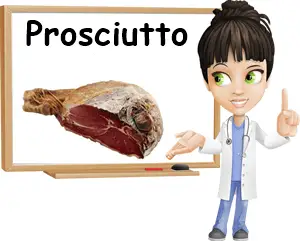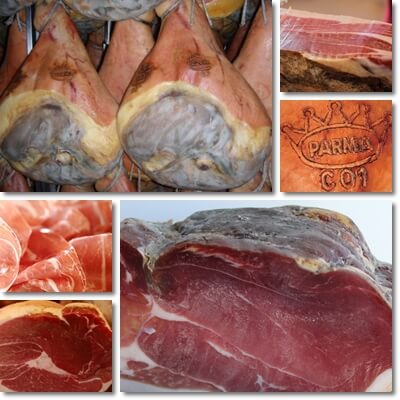Prosciutto crudo is a type of traditional Italian ham. It is a salted, dry-cured, aged ham made from the top part of pig hind legs. Prosciutto crudo is a ‘salume’, that is, an Italian specialty cold cut made exclusively from pork meat. As its name suggests, it is raw (or crudo), which means it’s uncooked. It’s not only perfectly safe to eat prosciutto crudo as it is, uncooked, but also recommended if you want to enjoy the original flavors of this traditional Italian ham. You can cook prosciutto crudo if you want to, but know that cooking it will cause it to change its texture and flavor profile, which kind of defeats the purpose of getting an uncooked, dry-cured specialty ham.
What kind of meat is prosciutto?
Prosciutto is made exclusively from pork meat. It is a type of traditional Italian cold cut called salumi (pl. salume). With a few exceptions, Italian salume are all made of pork meat, including prosciutto crudo, prosciutto cotto, mortadella, speck, capocollo, pancetta, guanciale and more. Of course, that doesn’t mean you can’t make it from any other type of meat. If a product labeled prosciutto is not made from pork, but from other type of meat, it should say so on the label. For example, wild boar prosciutto, lamb or sheep prosciutto (prosciutto d’agnello/pecora), goose prosciutto (prosciutto d’oca) should be labeled appropriately.

What cut of meat is prosciutto crudo?
Prosciutto crudo is made from pig hind legs. More exactly, it is made from the thigh or top part of pig hind legs, just like prosciutto cotto. The same cut of meat is used for other varieties of prosciutto, including prosciutto made from wild boar, lamb or sheep prosciutto, smoked prosciutto (prosciutto affumicato) or sweet prosciutto (prosciutto dolce). If it’s made from any other cut of meat, it should say so on the label. For example, shoulder prosciutto, or prosciutto di spalla in Italian, is made from pork shoulder, as opposed to traditional, DOP prosciutto crudo which is made from pig hind leg.
Why is prosciutto crudo so expensive?
Prosciutto crudo is essentially a dry-cured pork ham, so why is it so expensive? First of all, prosciutto crudo is made from selected pork meat that is salted and dry-cured, without the addition of harmful additives such as nitrites and nitrates. Not only this, but the curing process takes a minimum of 12-13 months and up to 2-3 years in order for specific flavors to develop in the ham.
This alone rises production costs significantly. Secondly, original Italian prosciutto is not just any deli ham – it’s an internationally recognized ham, a traditional Italian specialty ham with protected designation of geographical origin under European Union law.
Prosciutto from various Italian regions and provinces has PDO certification, meaning Protected Designation of Origin (in Italian, DOP – Denominazione di origine protetta). This certification is a recognition of quality and tradition and of the fact that the unique characteristics of the food product are determined by the geographic area where it is produced. As a DOP or PDO ham, prosciutto can only come from certain regions of Italy, where it is produced according to traditional recipes and from selected ingredients, which adds distribution costs to the already significant production costs associated with its artisanal quality. Hence the reason why it’s so expensive.

How is prosciutto crudo made?
Prosciutto crudo is made from selected pork meat from the top part of pig hind legs. The entire pig leg is cleaned and salted, then allowed to rest in a cool room for weeks to months, according to the indications of the traditional recipe employed. Salting and resting help both prevent spoilage of the meat and draw out any remaining blood.
Some recipes involve pressing the meat to draw out any remaining blood. Seasoning is applied along with the salt, usually black pepper, but also white pepper, juniper berries, bay leaves, rosemary and various other herbs and spices. Some types of prosciutto require several cycles of salting, as indicated by the traditional recipe used.
After the salting and resting, the ham is washed and hung to air-dry and age in a controlled environment that supports a prolonged curing process that can extend to 2-3 years. The parts of meat that are exposed (not covered by pork rind) are usually smeared with grease (lard), but also pepper, rice flour or various other ingredients to help form a protective layer that prevents spoilage during the curing process.
After passing inspection, a seal is applied to the pork rind, certifying the origin and, implicitly, quality of the product (e.g. prosciutto crudo di Parma).
Prosciutto crudo with DOP certification is exclusively produced in several Italian regions, provinces and comunes, such as the Parma province in the Emilia-Romagna region (where the famous Prosciutto di Parma is made) and the San Daniele del Friuli comune in the Friuli-Venezia Giulia region (where the famous Prosciutto di San Daniele is made).
Production outside of recognized geographical areas or using ingredients outside of these areas or prohibited food additives disqualifies the prosciutto from bearing the DOP certification of quality. Prosciutto with DOP certification is required to weigh no less than 7.5 – 8.5 kilograms, depending on the type.
Types of prosciutto crudo
According to geographical area (region, province, comune, city), the following types of Italian DOP prosciutto exist:
- Prosciutto di Parma DOP (also called Parma ham in English)
- Prosciutto di San Daniele DOP
- Prosciutto di Modena DOP
- Prosciutto Toscano DOP
- Prosciutto di Carpegna DOP
- Crudo di Cuneo DOP
- Prosciutto Veneto Berico-Euganeo DOP
- Vallée d’Aoste Jambon de Bosses DOP
Note: Prosciutto di Parma and Parma ham are the same thing. Parma ham is what prosciutto di Parma is called in English. In order to tell if they are original Italian Parma ham, look for two logos:
- An image of a crown with the word ‘PARMA’ written inside it, and other identification data. The logo should be stamped on the prosciutto rind.
- The DOP or PDO logo, a (typically) yellow and blue or yellow and red, round logo on the label certifying the origin and quality of the prosciutto.
Note: Each prosciutto has its own logo, branded on the rind, indicating the geographical area where it’s produced. The logo is pivotal for identifying the origin of the prosciutto.
What does prosciutto crudo look like?
Prosciutto crudo is a heavy, 7.5 – 8.5 kilogram piece of ham with bone, slightly rounded at its wider part. Prosciutto crudo is on the redder side, with different tones of pink-red and red, crossed by thin white veins of pork fat in a beautiful marbled effect. There’s usually a thicker band of white pork fat near the tan rind, which adds both visual appeal and flavor to the slices of prosciutto.
What does prosciutto crudo taste like?
Prosciutto crudo is a compact piece of ham, dense, slightly stringy, but extremely tender. It has a more pronounced taste than prosciutto cotto, with rich, aged pork flavors. The taste of prosciutto crudo varies slightly with each type. Different recipes requiring more than one cycle of salting, specific spices in specific amounts and, most important, the difference in curing time, all account for the variations in flavor profile.
Is it safe to eat prosciutto crudo?
You do not need to cook your prosciutto crudo. Although it’s raw (crudo, that is), it’s perfectly safe to eat as it is. Prosciutto crudo is actually meant to be eaten uncooked. What makes it safe for consumption is the curing process, done in such as manner that it results in a hygienic, perfectly edible food product of the highest standards. You can cook it if you want to, but know that cooking will alter its flavor profile and texture (it won’t taste bad, just different).
Italian prosciutto recipes
How do you eat Italian prosciutto? Just as its name says, you eat it ‘crudo’, that is, uncooked. This makes for easy, often no-cook Italian antipasto recipes that allow for the flavor of the prosciutto to shine. Prosciutto crudo is eaten finely sliced and uncooked:
- With melon. Slices of prosciutto crudo are wrapped around wedges of chilled melon such as cantaloupe, and eaten as appetizer, a classic Italian antipasto recipe.
- With figs. Another popular Italian antipasto recipe using prosciutto crudo is ‘fig roses’, essentially fine slices of prosciutto crudo rolled into a rose shape, fit inside ripe figs cut in quarters.
- With pears. Chilled Santa Maria pears, Bartlett or red Bartlett, d’Anjou or red Anjou wedges wrapped in fine slices of prosciutto crudo make an excellent antipasto.
- With tomatoes. Cherry tomatoes with a slice of prosciutto and a basil leaf, held together by a toothpick. You can add small mozzarella balls (called bocconcini).
- With asparagus. Asparagus tops are boiled, left to cool, then rolled into prosciutto slices. Bechamel sauce and grated Parmigiano Reggiano are added and then the asparagus rolls placed in the oven for 10-15 minutes.
- Bruschette and sandwiches. You can also make bruschette with mozzarella cheese, a slice of prosciutto crudo, arugula and figs. Or finger sandwiches with prosciutto crudo, endives, radicchio and brined olives, held in place with a toothpick.
- Charcuterie board. Fine slices of prosciutto crudo, prosciutto cotto and other salume, chilled melon, pear, figs, table grapes, red and yellow cherry tomatoes, black and green brined olives, endive and radicchio leaves, bocconcini mozzarella (small mozzarella balls), burrata (cream-stuffed mozzarella), fresh bread, focaccia, grissini or crackers, even citrus or fig marmalade.
